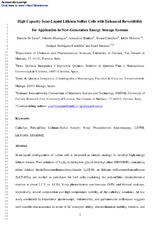High Capacity Semi-Liquid Lithium Sulfur Cells with Enhanced Reversibility for Application in New-Generation Energy Storage Systems
Autor
Di Leccea, Daniele
Marangona, Vittorio
Benítez, Almudena
Rodríguez-Castellón, Enrique
Hassoun, Jusef
Caballero Amores, Álvaro
Morales Palomino, Julián
Editor
ElsevierFecha
2019Materia
Catholyte polysulfideLithium-sulfur battery
X-ray photoelectron spectroscopy
LiTFSI
LiCF3SO3
DEGDME
METS:
Mostrar el registro METSPREMIS:
Mostrar el registro PREMISMetadatos
Mostrar el registro completo del ítemResumen
Semi-liquid configuration of sulfur cell is proposed as simple strategy to develop high-energy
lithium battery. Two solutions of Li2S8 in diethylene glycol dimethyl ether (DEGDME), containing
either lithium bis(trifluoromethanesulfonyl)imide (LiTFSI) or lithium trifluoromethansulfonate
(LiCF3SO3), are studied as catholytes for Li/S cells exploiting the polysulfides electrochemical
reaction at about 2.2 V vs. Li+/Li. X-ray photoelectron spectroscopy (XPS) and thermal analyses,
respectively, reveal composition and high-temperature stability of the catholyte solutions. Ad hoc
study conducted by impedance spectroscopy, voltammetry, and galvanostatic techniques suggests
well suitable characteristics in terms of Li+-transport ability, electrochemical stability window, and electrode/electrolyte interphase features. Cells with sulfur loading ranging from about 3 to 5 mg
cm−2 into the solution are successfully studied with remarkable performances in terms of current
rates, efficiency and cycle life. Hence, the lithium cells based on the catholyte deliver maximum
capacity of the order of 1100 mAh gS
−1 at C/10 rate and stable capacity of about 800 mAh gS
−1 at
C/3 rate with Coulombic efficiency exceeding 99%. Therefore, the catholyte solutions studied
herein are considered as a well suitable candidate for high-energy storage in next generation
systems, such as the intriguing hybrid and electric vehicles

